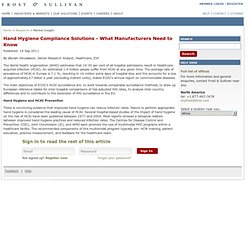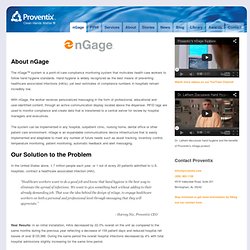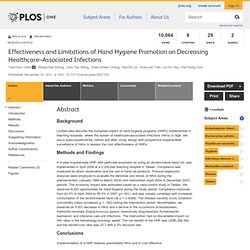

Handwashing Facts and Tips. According to the United States Department of Health and Human Services Centers for Disease Control and Prevention, hand washing or use of alcohol-based hand rubs has been shown to reduce overall infection rates.

As an alternative to traditional hand washing with soap and water, the Centers for Disease Control is recommending the use of waterless (alcohol-based) hand rubs by healthcare professionals for hand hygiene. Wash your hands with plain soap and water; or with antimicrobial soap and water if: Your hands are visibly soiled (dirty) Hands are visibly contaminated with blood or body fluids Before eating After using the restroom Wash all surfaces thoroughly -- fingers, between fingers, palms, wrists, back of hands. How does healthcare worker hand hygiene behaviour impact upon the transmission of MRSA between patients?: an analysis using a Monte Carlo model. Fast Facts - Hygiene - Healthy Water. Hospital Hygiene - How to Improve.
Healthcare Associated Infections: The Unknown Killer. Hand+hygiene+simple+and+complex. Hand Hygiene Compliance Solutions - What Manufacturers Need to Know. By Beulah Devadason, Senior Research Analyst, Healthcare, EIA The World Health organization (WHO) estimates that 10-30 per cent of all hospital admissions result in Healthcare acquired infection (HCAI).

An estimated 1.4 million people suffer from HCAI at any given time. The average rate of prevalence of HCAI in Europe is 7.1 %, resulting in 16 million extra days of hospital stay and this accounts for a loss of approximately €7 billion a year (excluding indirect costs), states ECDC's annual report on communicable diseases. The main objectives of ECDC's HCAI surveillance are: to work towards comparable surveillance methods, to draw up European reference tables for inter-hospital comparisons of risk-adjusted HAI rates, to analyse inter country differences and to contribute to the extension of HAI surveillance in the EU.
Hh_compliance_report_internet_201112. Simple Health Science: Hand Washing 101 at Australian Food Safety Blog. Graphjam.com has done it yet again, eloquently displaying anecdotal statistical data what we all know to be true: Handwashing Statistics When asking employees or owners in the food business what their #1 safety hazard in the kitchen is, they’ll always answer, ‘Hands’.

Considering the fact humans have between 2 and 10 million bacteria between the fingertip and elbow and this number doubles after using the toilet. It’s not surprising and in agreement with any health science degree class this is at the top of the list for potential safety hazards in the kitchen. The most common diseases spread by food business employees with unwashed hands include: These foodborne diseases can create havoc in food businesses if the proper steps aren’t taken, leading to destroyed reputations of great dining facilities and experiences.
Washing hands is something everyone has control over and is the easiest and most effective prevention measure to stop bacteria from spreading. Observation of food safety practices in catering using notational analysis. v14n4a12. Handwashing and the Law of Diminishing Returns. IPs spend a lot of time monitoring and educating about handwashing.

There are continuous debates about what the consequences should be for staff who are “caught” not washing their hands. One question that rarely is raised in Infection Control Committee meetings is whether there is an upper limit beyond which hand hygiene will no longer play a major role in HAI prevention. The answer can have profound effects on the amount of time and energy devoted to this one particular part of the IP role. Two recent articles have questioned the relationship between increasing handwashing compliance and reduction of health care infections. Biggs, Shepherd and Kerr (2008) performed a mathematical analysis of the transmission of Staph by healthcare workers’ hands that became contaminated by patient contact. Silvestri, Petros, Sarginson, et al (2005) conducted a literature review of 9 studies that looked at the relationship between hand hygiene compliance levels and actual infection rates.
Less hospital beds can mean more infections. 28 October 2008 The University of Ulster's Joseph Cunningham investigates the link between hospital overcrowding and infection levels and considers possible solutions The report into the outbreak of Clostridium difficile (C. diff) at Maidstone and Tunbridge Wells Hospital Trust 1 , carried out by the Healthcare Commission, and the number of deaths in this trust is an indictment of conditions of care in British hospitals. At the time of its release various commentators spoke of this as a one-off, something that was not typical. However, a similar report by the Healthcare Commission 2 report one year earlier on a C. diff outbreak in Stoke Mandeville revealed the same issues. A recent outbreak of C. diff in a Northern Ireland trust with the related deaths of 54 patients since July 2008, 40 of which happened since January 2008, shows that basic issues in the management of beds and care may still have to be addressed.
The hospital bed has been falling out of favour. Proventix. About nGage The nGage™ system is a point-of-care compliance monitoring system that motivates health care workers to follow hand hygiene standards.

Hand hygiene is widely recognized as the best means of preventing healthcare associated infections (HAIs); yet best estimates of compliance numbers in hospitals remain incredibly low. With nGage, the worker receives personalized messaging in the form of professional, educational and user-identified content, through an active communication display located above the dispenser. RFID tags are used to monitor compliance and create data that is transferred to a central server for review by hospital managers and executives. Our Solution to the Problem In the United States alone, 1.7 million people each year, or 1 out of every 20 patients admitted to U.S. hospitals, contract a healthcare associated infection (HAI). Proventix Partners with Synapse. Hand Hygiene Australia - 5 Moments For Hand Hygiene. Ginny's Story. Baptist Health Minute: Princeton's Proventix Hand Hygiene System.
Proventix nGage. Proventix's nGage System. Effectiveness and Limitations of Hand Hygiene Promotion on Decreasing Healthcare–Associated Infections. Background.

Measurement - Hand Hygiene. Measuring Hand Hygiene Adherence: Overcoming the Challenges The Joint Commission is releasing “Measuring Hand Hygiene Adherence: Overcoming the Challenges ,” to help health care organizations target their efforts in measuring hand hygiene performance.

The monograph is designed to address "everything you ever wanted to know about hand hygiene measurement but were afraid to ask. " Factors Impacting Hand Hygiene Compliance Among New Interns: Findings From a Mandatory Patient Safety Course. Patient-Safety Center Tests RFID-enabled Hand Sanitizers. The University of Miami-Jackson Health System (UM-JMH) Center for Patient Safety is piloting an RFID-based system intended to track the hand-washing compliance of hospital employees, thereby combating an age-old problem of infection transmission that occurs in medical facilities.

The system tracks who washed their hands, and when. If a doctor or nurse visits a patient's bed without first washing his or her hands, an audible alarm offers a reminder. The Center for Patient Safety hopes to increase the rate of staff hand-washing, thus decreasing the number of patient infections. The system, which includes Versus Technology's hybrid infrared-RFID tags, as well as interrogators installed by RTLS health-care systems integrator Dynamic Computer Corp. (DCC), is the latest effort, this time a technological one, to address the problem of hospital-acquired infections, often occurring in intensive care or emergency units.